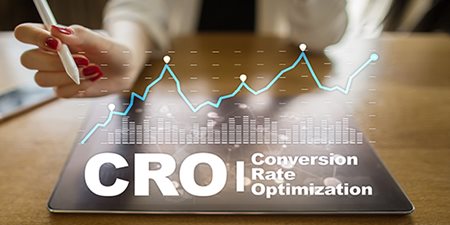Optimization Prime – Conversion Rate Edition: Part 3 of 7
“We’ve suffered losses, but we’ve not lost the war.” — Optimus Prime
This observation rings true when the loss of customers can be trace to poor user experience, forms, calls to action, and content. Virtually, all your conversion points.
Third in our seven-part optimization series—conversion.

Most of today's marketers are focused on driving traffic and converting leads, which will ultimately power sales and generate business revenue. Simple? Yes. The standard? Of course. Enter conversion rate optimization (CRO). Increasingly, businesses are utilizing data and predictive analytics to map the buying cycle and identify their target audience’s buying behavior to ideally optimize every point of the buyer’s journey they convert. But before we jump into optimizing conversions, let’s narrow our focus to explore conversion as it relates to conversion rates.
A conversion is a generalized term for a customer who completes a site goal. Site goals vary from business-to-business and vary in terms of size. Larger conversions, such as a purchase, are macro-conversions, whereas watching a video is a micro-conversion.
Examples of macro-conversions:
Examples of micro-conversions:
A conversation rate is an actual calculation which equals the number of times a user completes a goal (conversion) divided by your site’s total traffic. Many CEOs of businesses will ask, “What is a good conversion rate?” The typical answer is “a high one.” A large number of companies compare themselves to everyone else using industry benchmarks; however, the problem with relying solely on those statistics is that there’s a significant portion of the total equation they don’t consider. The more effective line of thinking around good conversion rate should be: “A good conversion rate is one that is higher than it is now.”
What is Conversion Rate Optimization (CRO)?
According to Moz, “Conversion rate optimization (CRO) is the systematic process of increasing the percentage of website visitors who take a desired action — be that filling out a form, becoming customers, or otherwise. The CRO process involves understanding how users move through your site, what actions they take, and what's stopping them from completing your goals.”
Not to be confused with conversion optimization for SEO or paid ads which focus on conversions of visitors driven to your website, conversion rate optimization happens after the visitors arrive at your site.
Benefits of CRO
The obvious advantage of CRO—more customers amount to more revenue. CRO is essential because, more than likely, you’ve funded a marketing campaign to entice traffic to your site; thus, a higher conversion means a better return on that investment. It’s also a very cost-effective way to convert customers you already have as opposed to spending money on the acquisition of new people to your site. Lastly, with our limited attention span and patience, CRO can capture and hold the user’s interest to serve them the information they are looking for. A mantra of marketing is, “It’s much easier to double your business by doubling your conversion rate than double your traffic.”
Be that as it may, it is also valuable to note that CRO is about getting more of the ideal type of customers than simply optimizing for optimizations’ sake.
Getting Started with CRO
When beginning your undertaking of optimizing conversion rates, you need to know the where to, what to, and who to optimize for. The two methods to complete this are ‘analytics and people’—or ‘quantitative and qualitative’, respectively.
Analytics, a.k.a Quantitative
This method is the collection of data from your site to showcase how users interact with your website. This data provides information like:
-
Where users enter and exit your site
-
The features they interact with
-
Channel or referrer user came from
-
Devices they browse on
-
Demographic data such as age and interest
People, a.k.a Qualitative
This method is the collection of data and information from your users directly through such forms as surveys, focus groups, and user testing. This data provides information such as:
-
The reasons why the engaged or visited your site
-
The reasons that make your site different from competitors
-
The words they use to describe your products, services, or both
-
The pain points they want to address
Of course, there is a third method—the bad method—in which you guess, or assume, or just try things because you’ve seen your competitors doing it.
Conversion Rate in Marketing
As noted above, CRO can take many forms, but it does consist of a few essential areas. To get the most out of conversion rate optimization, you need the following in place:
-
Call to action (CTA): To inform your customer to do exactly what you want them to do in an attention-grabbing way
-
Forms: To capture potential lead information which you can use for marketing efforts
-
Conversion funnel: To be based on your target audience’s behaviors and touchpoints
-
Multivariate testing (MVT): To test multiple versions of the same asset
-
A/B testing: To test two versions of an asset that has one small variable
-
SEO: To improve your search engine rankings
-
Website usability: To improve user experience (UX)
Conversion Rate Best Practices
Best practices—in all areas, not just CRO—can help you improve your results from the get-go. Below are some of the tried-and-true best methods for conversion rate optimization:
Identify your potential customer
Take the time to truly delve in and identify who does and does not fit within your target market. Break that down further into personas (check out this 'How to Create Targeted Customers Personas' article). Each of your marketing messages needs to be targeted, including your CTAS, so make sure you know your customer to create a compelling message that they cannot ignore.
Survey
We cannot stress enough on how valuable it is to understand your users and their behavior by way of gathering data. Survey your users through quick, brief surveys, and avoid repetitive questions.
Nom, Nom, Nom! Stats!
Expanding on the survey factor above, you can collect and analyze data through multiple tools such as Crazy Egg, Hello Bar, and Google Analytics to cover all of your bases. This data will start to present patterns which you can use to boost your conversion rates.
Test
Recognize and understand the patterns. A/B and multivariant testing is key to conversion rate optimization. Manipulate those patterns and employ the changes to see what happens and what ultimately works the best for you.
Define the Journey
Just like mapping your user-personas, mapping your buyers’ journey can harvest a bumper crop of great data to influence your CRO.
Heatmap Important Content
Pay special attention to the most important pages on your website, like your landing pages and product pages. Heatmap analysis can highlight where people click and how they use the page, which, in turn, can optimize for better conversions.
Don’t Guess
Do you recall what I said about ‘the bad method’? Don’t ever guess or assume. With data collection and testing, you can make thoroughly solid decisions, not flimsy conjectures.
Be the ‘Lumiere’ of Your Site
Life is so unnerving when your guests are not converting. Illuminate the way for visitors and guide your customers through your site to where you want to lead them with the use of CTAs and directional indicators.
Join us here at CMSC Media next Tuesday, July 9th, 2019 to read part four of our Optimization Prime series—Search edition.
Catch up with our Optimization Prime series:

Lynette Sawyer
Lynette Sawyer is a Web Project Manager for Falcon-Software, a digital web agency founded in 1994. For the last 13-years Lynette has been in various digital capacities and her expertise goes beyond Project Management. Lynette brings experience and knowledge in graphic design, marketing communications, project management, product management and engagement.